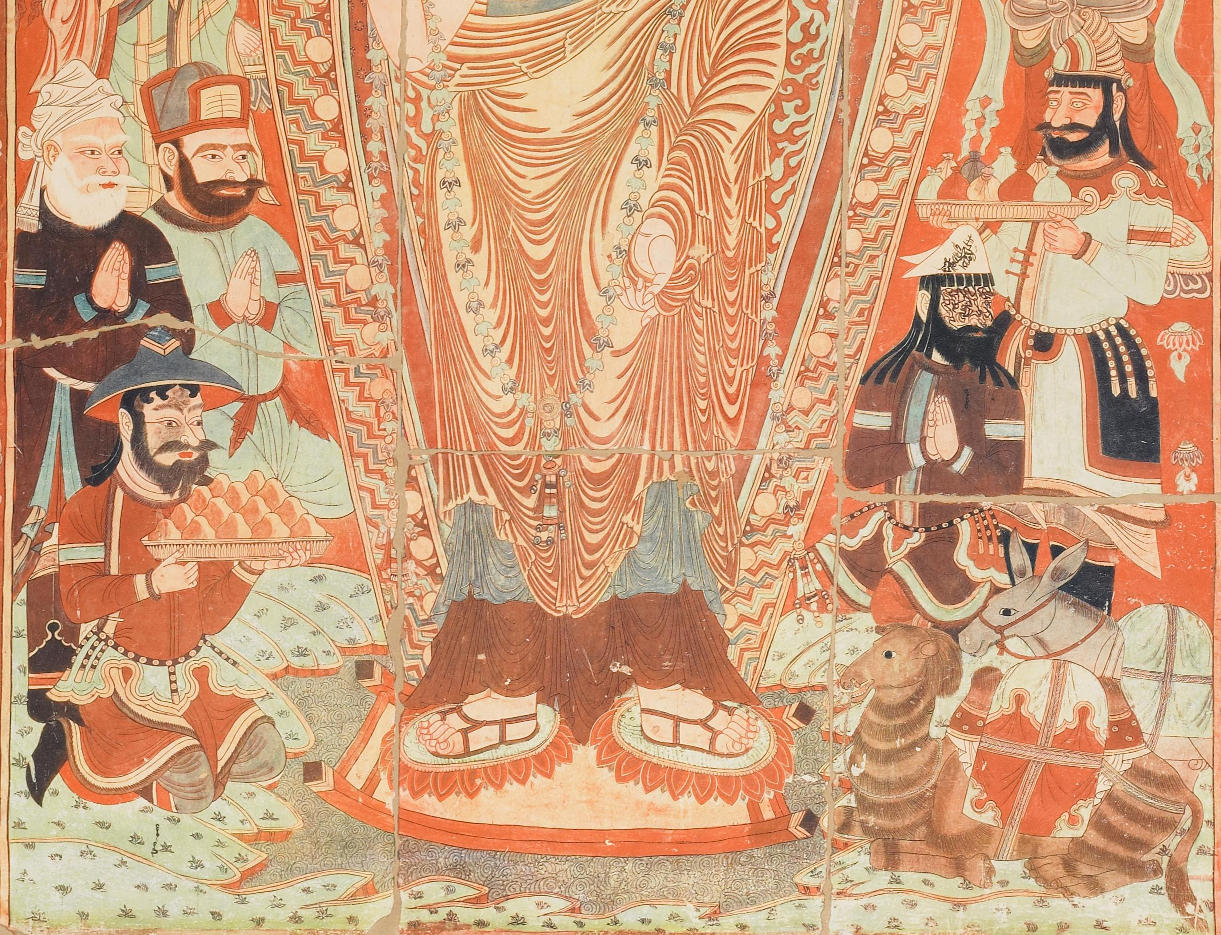
Create an Amazon Wedding Registry
Detail of Bezeklik (Bšzšklik) Fresco
Praņidhi scene No. 14, Temple No. 9, Bšzšklik

An even larger image of this Bezeklik fresco, Pranidhi scene No. 14, Temple No. 9, Tarim Basin.


Nine accompanying figures surround the Buddha; five of them appear to be portraits, the others are painted more or less schematically. The portrait figures are the adorants kneeling at the feet of the Buddha and making sacrifices, apparently belonging to the Iranian race.
To the right of the Buddha are two of these adorers. The one in front kneels in an adoring position, his head turned away from the object of his worship. His clothing consists of a fur-trimmed, brown tunic, closed in the middle or on the right side with a green fur-trimmed edge, a belt, pieces of jewelry and red-brown saddleback trousers tucked into high boots. The face is white with a strong black beard and hair; the latter falls in longer and shorter ribbon-like strands down over the neck, sides and forehead. An idle pilgrim, or some other malevolent hand, has scrawled this man's face and the white, conical, two-pointed cap with senseless brushstrokes.
Before him lie a donkey and a two-humped camel with loads; the latter's nasal peg, with its lead rope attached, is shown with care.
Behind it rises the standing figure of a grim-looking man in a green, fur-trimmed robe, who offers a bowl with bulging bags (gold dust?). The face is of the European type, the eyes are light green, but the beard and hair are black. The hat is noteworthy, the shape of which is most reminiscent of the eagle-winged hats worn by Sassanid princes. The gray hose are tucked into wide high boots; a corner of the undergarment peeks out from under the skirt.
On the left side three adorants form a group. In the foreground a man is kneeling, with a bowl, on a beautiful border showing a leaf ornamentation, offering a number of irregularly shaped sacrificial pyramids made of rice, butter etc. (?). His tunic, closed to the right, resembles that of the people described; The hips pieces below the narrow leather belt are adorned with round ornaments, which, like the trousers and boots, resembles the articles in question for the people already described, appear clearly set off as a special item of clothing. The bowl-like hat, the different hairstyle, the sparse beard, however, distinguish this person from the four other adorers.
The old man standing behind him, like his companion kneeling to his right, shows West Asian facial features.1 He wears a turban; the cut of his tunic resembles that of his companions, but appears to be closed at the front and underneath the belt, which here is a twisted cloth, to be open to the side. He still seems to be wearing a red undergarment; the white trousers are in high, ornate boots. His neighbour kneeling to the right, a younger man with a strong brown beard, wears a longer fur-trimmed robe with a twisted red cloth as a belt. Gold bracelets appear on his wrists. His cone-shaped cap shows upright flaps in front and behind, which perhaps could be folded down to protect against the sun.
1 The naive painter has placed the left nostril hidden by the mustache in the tip of the nose.
Source: Plate 28, Chotscho by Albert von Le Coq